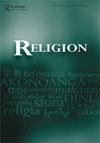The remaking of a Tibetan mountain cult festival: the worship of landscape deities in the Rebgong Valley, Amdo
IF 0.9
2区 哲学
0 RELIGION
引用次数: 1
Abstract
ABSTRACT Festivals in honor of mountain deities were revived across the Tibetan plateau in the 1980s, some years after the end of the Cultural Revolution (1966–1976) in the People's Republic of China. This article, primarily analyzes the development of one mountain festival in Amdo, Qinghai, focusing on the decades from its revival until today. During mountain deity festivals, primarily men from multiple villages, a range of religious specialists, and representatives of local authorities gather at a stone cairn on a mountain top, where a variety of rites, ceremonies, and games takes place. In the ‘old society’ the chieftain of a congregation of villages had an important role as patron, mediating between the deity, the deity's medium, religious specialists and villagers, while his function has diminished in the revived festival. Faced with major social-economic-political changes, while retaining and recreating many elements of tradition, striking transformations in the festival's structures of patronage, piety, and play have transformed its human network, its format, and its significance.西藏崇山节的重塑:安多热贡山谷的景观神崇拜
20世纪80年代,在中华人民共和国文化大革命(1966–1976)结束后的几年里,青藏高原各地重新举办了山神节。本文主要分析了青海安多一个山地节的发展历程,着重分析了它从复兴到今天的几十年。在山神节期间,主要是来自多个村庄的男子、一系列宗教专家和地方当局的代表聚集在山顶的石堆旁,在那里举行各种仪式、仪式和游戏。在“旧社会”中,村庄会众的首领作为赞助人发挥着重要作用,在神、神的媒介、宗教专家和村民之间进行调解,而在复兴的节日中,他的作用已经减弱。面对重大的社会经济政治变化,在保留和重建许多传统元素的同时,节日的赞助、虔诚和娱乐结构发生了惊人的变化,改变了它的人际网络、形式和意义。
本文章由计算机程序翻译,如有差异,请以英文原文为准。
求助全文
约1分钟内获得全文
求助全文
来源期刊

RELIGION
RELIGION-
CiteScore
2.70
自引率
0.00%
发文量
58
期刊介绍:
RELIGION is an internationally recognized peer-reviewed journal, publishing original scholarly research in the comparative and interdisciplinary study of religion. It is published four times annually: two regular issues; and two special issues (or forums) on focused topics, generally under the direction of guest editors. RELIGION is committed to the publication of significant, novel research, review symposia and responses, and survey articles of specific fields and national contributions to scholarship. In addition, the journal includes book reviews and discussions of important venues for the publication of scholarly work in the study of religion.
 求助内容:
求助内容: 应助结果提醒方式:
应助结果提醒方式:


